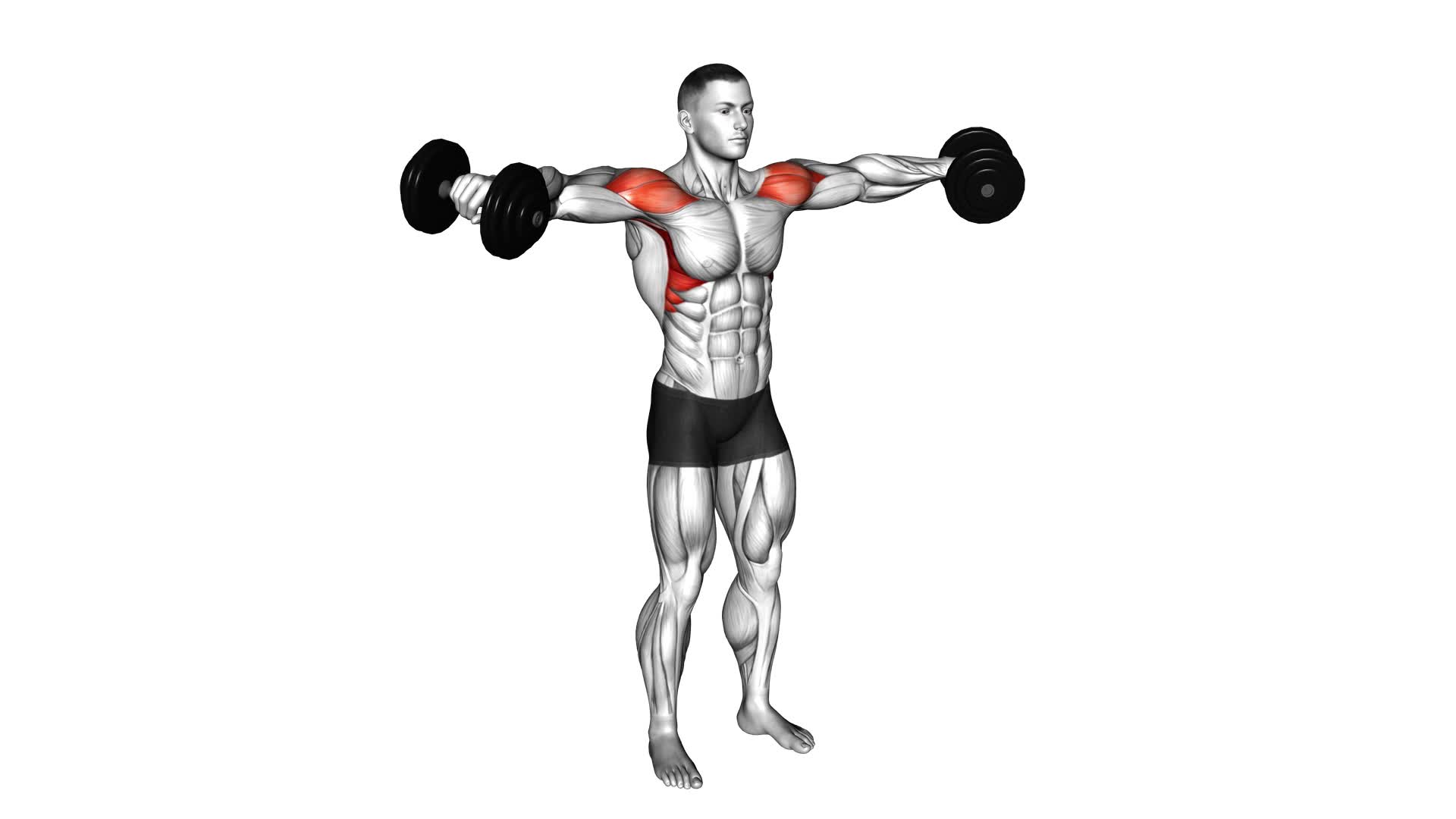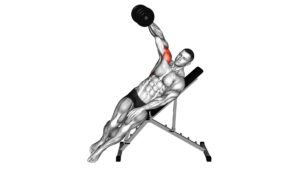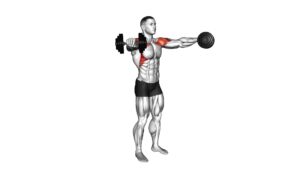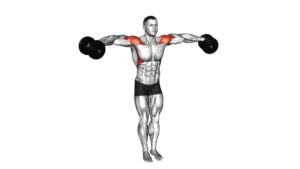Dumbbell Lateral Raise – Video Exercise Guide & Tips

Are you looking to tone and strengthen your shoulders? Look no further than the dumbbell lateral raise!
Watch This Exercise Video
This exercise targets your deltoids and helps to improve shoulder stability.
In this video exercise guide, we will show you the proper form, common mistakes to avoid, variations and progressions, as well as tips to increase intensity.
Incorporate the dumbbell lateral raise into your workout routine for sculpted and strong shoulders.
Let's get started!
Key Takeaways
- Dumbbell lateral raises target and strengthen the lateral deltoid muscle.
- Proper form and avoiding common mistakes are crucial for maximizing the benefits of this exercise.
- Injury prevention techniques such as using appropriate weights and maintaining controlled movements are important.
- Variations and progressions can be incorporated to target different muscles and increase intensity.
Benefits of the Dumbbell Lateral Raise
To fully understand the benefits of the Dumbbell Lateral Raise, it's important that you recognize how it targets and strengthens specific muscles in your shoulders and upper body. This exercise primarily focuses on the lateral deltoid, which is the muscle responsible for raising your arms out to the side. By performing the Dumbbell Lateral Raise with proper technique, you can effectively activate and strengthen this muscle.
During the exercise, make sure to keep your core engaged and maintain a slight bend in your elbows. Start by standing with your feet shoulder-width apart and holding a dumbbell in each hand. With a controlled motion, raise your arms out to the side until they're parallel to the floor, forming a 'T' shape with your body. Pause for a brief moment at the top of the movement, ensuring that you feel the contraction in your lateral deltoids. Slowly lower the dumbbells back to the starting position.
By regularly incorporating the Dumbbell Lateral Raise into your workouts, you can improve your shoulder strength and stability, enhance your posture, and develop a more defined upper body.
Now, let's move on to discussing the proper form for the dumbbell lateral raise.
Proper Form for the Dumbbell Lateral Raise
Now, let's dive into the proper form for the Dumbbell Lateral Raise, so you can perform this exercise effectively and maximize its benefits.
To ensure proper execution and avoid injury, follow these guidelines:
- Stand with your feet shoulder-width apart and hold a dumbbell in each hand, palms facing inwards.
- Keep a slight bend in your elbows and maintain a straight posture throughout the movement.
- Lift the dumbbells out to your sides, with a controlled motion, until they reach shoulder level. Avoid swinging or using momentum.
- Pause for a moment at the top to engage your shoulder muscles, then slowly lower the dumbbells back to the starting position.
- Remember to breathe steadily throughout the exercise and focus on maintaining shoulder stability.
When performing the Dumbbell Lateral Raise, it's important to prioritize proper form over heavy weights. Start with lighter dumbbells and gradually increase the load as you build strength. This progressive overload approach will help you avoid undue strain on your shoulder joints and improve overall shoulder stability.
Common Mistakes to Avoid
To ensure you perform the dumbbell lateral raise correctly and avoid common mistakes, it's important to understand proper form and injury prevention techniques.
By demonstrating the proper form, you can ensure you're targeting the correct muscles and maximizing your results.
Additionally, incorporating injury prevention techniques, such as avoiding excessive weight or jerky movements, will help keep you safe and reduce the risk of injury.
Proper Form Demonstration
Avoid these common mistakes to ensure proper form during the dumbbell lateral raise exercise:
- Keep your back straight: Avoid leaning forward or arching your back during the exercise. Maintain a neutral spine to engage your core and target the lateral deltoids effectively.
- Don't use excessive weight: Using weights that are too heavy can compromise your form and put unnecessary strain on your shoulders. Start with lighter weights and gradually increase as you gain strength and confidence.
- Control the movement: Avoid swinging or jerking the dumbbells up. Instead, focus on a slow and controlled motion, lifting the weights out to the sides and keeping your elbows slightly bent. This will maximize the tension on your lateral deltoids and minimize the involvement of other muscles.
By following these proper technique for lateral raises, you'll enhance the effectiveness of the exercise and reduce the risk of injury.
Now, let's move on to the next section about injury prevention techniques.
Injury Prevention Techniques
To prevent injuries while performing the dumbbell lateral raise, focus on maintaining proper form and technique.
Injury prevention techniques are essential to ensure a safe and effective workout.
Firstly, avoid using weights that are too heavy, as this can strain your shoulder muscles and increase the risk of injury. Start with lighter weights and gradually increase the load as your strength improves.
Secondly, be mindful of your range of motion. Avoid swinging the dumbbells or using momentum to lift the weights. Instead, focus on controlled movements, lifting the weights out to the sides until they're parallel to the floor.
Lastly, listen to your body and stop if you experience any pain or discomfort.
Now, let's move on to the next section, where we'll discuss advanced variations and progressions to challenge yourself further.
Variations and Progressions
To increase the challenge and effectiveness of your dumbbell lateral raises, try incorporating variations and progressions into your workout routine.
Here are three variations that will help target different muscles and increase muscle activation:
- Arnold Press: Start by holding the dumbbells at shoulder level with your palms facing towards you. As you lift the dumbbells up, rotate your palms to face forward, similar to a shoulder press. This variation not only targets your lateral deltoids but also engages your front deltoids and upper chest.
- Bent-Over Lateral Raise: Stand with your feet shoulder-width apart and hinge forward at your hips, keeping your back straight. Hold the dumbbells in front of you with your palms facing each other. Lift the dumbbells out to the sides, focusing on squeezing your shoulder blades together. This variation puts more emphasis on your rear deltoids and upper back muscles.
- Cable Lateral Raise: Attach a cable machine to a low pulley and stand with your side facing the machine. Hold the handle with your closest hand and step away, creating tension in the cable. Lift the handle out to the side, keeping your arm straight. This variation provides constant tension throughout the movement, challenging your lateral deltoids.
Incorporating these variations into your dumbbell lateral raises won't only add variety to your workout but also help you target different muscles and increase muscle activation. Remember to start with lighter weights and focus on proper form before progressing to heavier weights.
Tips to Increase Intensity
To increase the intensity of your dumbbell lateral raises, there are several tips you can follow.
First, implement progressive weight training by gradually increasing the weight of the dumbbells you use. This will challenge your muscles and promote growth.
Second, focus on maintaining proper form techniques throughout the exercise to ensure you're targeting the correct muscles and avoiding injury.
Lastly, consider supersetting your dumbbell lateral raises with other exercises to maximize your workout and increase overall intensity.
Progressive Weight Training
Increase the intensity of your weight training by progressively adding more weight. This is a key strategy for maximizing your muscle development and achieving your fitness goals.
Here are three tips to help you implement progressive weight training effectively:
- Gradually increase the weight: Start with a weight that challenges you but allows you to maintain proper form. As you become stronger, add small increments of weight over time. This gradual progression will stimulate your muscles to adapt and grow.
- Focus on compound exercises: Incorporate weightlifting techniques that target multiple muscle groups simultaneously, such as squats, deadlifts, and bench presses. These exercises require more effort and enable you to lift heavier weights, leading to greater muscle development.
- Track your progress: Keep a record of the weights you lift for each exercise. Regularly review your log and aim to progressively increase the weights you lift. This will help you stay accountable and monitor your progress over time.
Proper Form Techniques
To increase the intensity of your dumbbell lateral raise exercises, focus on maintaining proper form throughout the movement. This isn't only important for maximizing the effectiveness of the exercise but also for injury prevention.
Keep your back straight, engage your core, and avoid using momentum to lift the weights. Start with lighter weights and gradually increase the load over time to achieve progressive overload, which is essential for muscle growth.
Remember to keep your shoulders relaxed and avoid shrugging them up towards your ears. This will help to isolate the lateral delts and prevent strain on the neck and traps.
By maintaining proper form and gradually increasing the weight, you can ensure that you're challenging your muscles and making progress.
Now, let's move on to the next section about supersetting with other exercises.
Supersetting With Other Exercises
To further increase the intensity of your dumbbell lateral raise exercises, try supersetting them with other exercises. Supersetting involves performing two exercises back-to-back without any rest in between. This technique not only saves time but also challenges your muscles in new ways, leading to greater gains in strength and muscle definition.
Here are three advanced variations of supersetting that you can incorporate into your workouts:
- Compound Supersets: Combine your dumbbell lateral raises with compound exercises like push-ups or squats. This won't only target your shoulders but also engage multiple muscle groups, making your workout more efficient.
- Pre-Exhaustion Supersets: Begin with a shoulder isolation exercise, such as lateral raises, and immediately follow it with a compound movement that also targets the shoulders, such as overhead presses. This method pre-fatigues your muscles, forcing them to work harder during the compound movement.
- Antagonist Supersets: Pair your dumbbell lateral raises with exercises that target opposing muscle groups, such as bent-over rows or bicep curls. This allows you to work different muscles simultaneously, increasing the overall intensity of your workout.
Incorporating these supersetting variations into your dumbbell lateral raise routine will provide numerous benefits, including improved muscular endurance, increased calorie burn, and enhanced muscle definition.
Incorporating the Dumbbell Lateral Raise Into Your Workout Routine
To incorporate the dumbbell lateral raise into your workout routine, start by selecting an appropriate weight dumbbell for your fitness level. You want to choose a weight that challenges you but still allows you to perform the exercise with proper form. Once you have your dumbbells, stand with your feet shoulder-width apart and hold one dumbbell in each hand at your sides.
To perform the dumbbell lateral raise, lift your arms out to the sides until they're parallel to the floor, keeping a slight bend in your elbows. Pause for a moment at the top and then slowly lower the dumbbells back down to your sides. Repeat for the desired number of repetitions.
If you find the exercise too challenging, you can modify it by using lighter weights or by performing the exercise seated. Seated lateral raises can help to reduce the strain on your lower back and allow you to focus more on your shoulders.
Incorporating lateral raises into your shoulder workouts can help to strengthen and tone your deltoids, the muscles in your shoulders. You can include lateral raises as part of a shoulder-focused workout or incorporate them into a full-body routine.
Remember to always listen to your body and adjust the weights and repetitions as needed to fit your fitness level.
Frequently Asked Questions
How Much Weight Should I Use for the Dumbbell Lateral Raise?
When performing the dumbbell lateral raise, it's important to choose the right weight for your ability level. Start with a weight that challenges you but allows you to maintain proper form.
As you get stronger, you can gradually increase the weight. It's better to use lighter weights with proper form than to use heavier weights with poor form.
Remember to focus on the mind-muscle connection and feel the burn in your lateral deltoids.
Can I Perform the Dumbbell Lateral Raise Seated Instead of Standing?
Yes, you can perform the dumbbell lateral raise seated instead of standing. Doing the exercise in a seated position can provide several benefits.
Firstly, it helps to stabilize your body and prevents any swinging or cheating movements.
Secondly, it puts less stress on your lower back, making it a suitable option if you have any back issues.
Lastly, it allows you to focus more on isolating and targeting your shoulder muscles, leading to better results.
Is It Necessary to Perform the Dumbbell Lateral Raise on Both Sides or Can I Just Focus on One Side?
To get the most out of your workout, it's important to perform the dumbbell lateral raise on both sides. Doing a one-sided dumbbell lateral raise can help you achieve better symmetry and balance in your shoulders.
Plus, it engages more muscles, which leads to increased strength and stability. Unilateral training has its benefits, so don't skip out on working both sides for optimal results.
How Often Should I Incorporate the Dumbbell Lateral Raise Into My Workout Routine?
To maximize results, it's important to know how to properly perform the dumbbell lateral raise.
But before we get into that, let's address how often you should incorporate this exercise into your routine. Consistency is key, so aim for 2-3 times per week. This will allow your muscles to recover while still getting the benefits.
Now, let's dive into the proper form and common mistakes to avoid when doing the dumbbell lateral raise.
Can I Substitute the Dumbbell Lateral Raise With Any Other Exercises to Target the Same Muscles?
If you're looking to target the same muscles as the dumbbell lateral raise, there are a few other exercises you can try.
One option is the cable lateral raise, which works the same deltoid muscles.
You can also try the bent-over lateral raise, which targets the rear deltoids.
Another alternative is the upright row, which engages both the deltoids and the traps.
Experiment with these exercises to find what works best for you.
Conclusion
Incorporating the dumbbell lateral raise into your workout routine can help strengthen and tone your shoulder muscles.
By following proper form and avoiding common mistakes, you can maximize the benefits of this exercise.
Additionally, incorporating variations and progressions can keep your workouts challenging and help you see continued improvement.
Remember to increase intensity gradually and listen to your body to avoid injury.
So grab some dumbbells and start incorporating the dumbbell lateral raise into your routine for stronger, more sculpted shoulders.

Author
Years ago, the spark of my life’s passion ignited in my mind the moment I stepped into the local gym for the first time. The inaugural bead of perspiration, the initial endeavor, the very first surge of endorphins, and a sense of pride that washed over me post-workout marked the beginning of my deep-seated interest in strength sports, fitness, and sports nutrition. This very curiosity blossomed rapidly into a profound fascination, propelling me to earn a Master’s degree in Physical Education from the Academy of Physical Education in Krakow, followed by a Sports Manager diploma from the Jagiellonian University. My journey of growth led me to gain more specialized qualifications, such as being a certified personal trainer with a focus on sports dietetics, a lifeguard, and an instructor for wellness and corrective gymnastics. Theoretical knowledge paired seamlessly with practical experience, reinforcing my belief that the transformation of individuals under my guidance was also a reflection of my personal growth. This belief holds true even today. Each day, I strive to push the boundaries and explore new realms. These realms gently elevate me to greater heights. The unique combination of passion for my field and the continuous quest for growth fuels my drive to break new ground.







